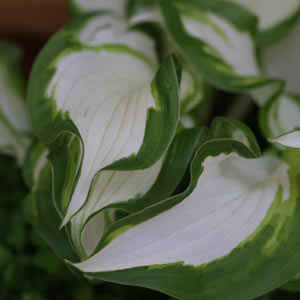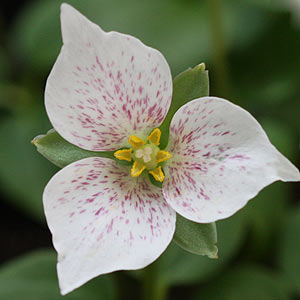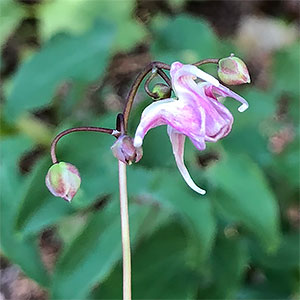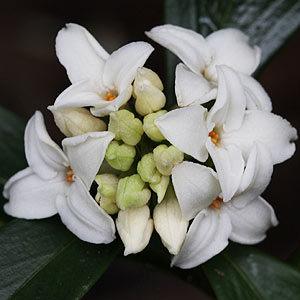
With some large deciduous trees that create shade from autumn to fall our garden is a natural habitat for shade plants.
A few misconceptions exist about shade loving plants, one is that they do not have colourful flowers. We grow red flowering trilliums and astilbe for starters and both add colour.
Hostas (pictured right) are mainly grown for the foliage and many have very colorful foliage that can brighten a shaded corner in the garden.
It is not only trees that create shade, many north facing gardens and courtyards will be shaded by buildings so they need special plants as well. We also grow a number of white flowering species including anemones, Trilliums, Galanthus and Hostas, and yes they will all flower in the shade. Hellebores of course are another worth considering.

However in shade, white is a great colour, it really lifts a dark area, so go for lighter colours to brighten up that shady corner.
Flowering plants are very desirable, they provide color and interest, however consider plants with variegated foliage for year round interest in shaded positions.
Plants with great foliage should also be considered, try Arisaema candidisimum, it starts in late spring with very attractive foliage and follows with large leathery textured leaves that last through summer. Its not an evergreen but works well in a clump of 6-10 plants. Bergenia cordifolia is another, great foliage for most of the year with flowers in winter.
Shade Plant List
Plants For Dry Shade
Dry Shade or Damp Shade

Another misconception is that shade means moist, it can, but not always, and in fact beneath large trees moisture can be a little difficult to maintain, especially in summer. The roots of trees really suck the water out of the soil so shade can be very dry.
We find that Clivia grow well for us in shade, and they cope well with the dry conditions, other plants include Epimediums, and they have colourful foliage and flowers, although they are small.
And of course shade tolerant shrubs such as Mahonia and Daphne are also wonderful, the brilliant yellow flowers of the Mahonia will brighten an y shady position, and the Daphne flowers are small, however they are fragrant as well.
Plants that grow well in shaded positions in the garden fall into a number of categories including best plants for deep , dry and damp shade.
Plants vary greatly as to how much shade they require or can tolerate, some plants are shade lovers, they actually require shade to grow well, other plants are tolerant, they grow fairly well in but actually prefer more light.
It is essential when selecting plants for a shaded area of the garden to first look at the type of soil and conditions that exist.

Plants selected for very deep shaded areas will differ to those selected for dappled or light shade. Moisture requirements must be considered
Trilliums grow well in shade
It also needs to be remembered that you can have dry, or damp shade, very different conditions that suit different plants. Plants such as Rodgersia and Astilbe require moisture, with Rodgersia preferring it decidedly on the damp side.
Plant for shade will differ according to climate zone
And as the USA has such a variable climate, plants suited to one zone will not be of much use in other areas.
This is especially true of the sub tropical understory shade loving plants which may well be limited to Florida.
So in the south plants such as Crotons will do well in part shade. While Cordylines will cope well with deeper shade.
Best Plants for Shade
This totally depends on the situation, very shady and very wet to part shade and dry. Look carefully at the conditions and read up on the different requirement for each plant, some plants will just not tolerate much sun at all, others are more adaptable.
Plants vary greatly in the amount of shade that they grow well in, however it is possible to find groundcovers, perennials, bulbs and flowering plants that are suitable.
Woodland plants such as Trillium rivale (pictured right) are an excellent choice for the shade garden
Most plants that are listed here prefer dappled shade, very deep shaded positions can be a difficult area for all but the toughest plants. We provide a list of proven best shade plants for the garden.
- Clivia Plants are a valuable shade plant as they do well in dry shade. Clivia cope with both the shade and dryness that can occur beneath large trees with ease. Bright flowers are a bonus, and they are not invasive.
- Hellebores are another perennial plant that does well beneath trees. With lots of new cultivars available including yellow and white flowering hellebores, hellebores are another tough shade plant.
- Trillium are a favorite shade loving woodland plant and require a humus rich moist but well drained soil. Trillium flowers are very attractive, however the foliage also looks great.
- Ferns the ultimate shade plant and are a great standby for shaded corners of the garden, no flowers as such but a great variety of foliage in terms of both texture and color.
- Dicentra the ‘bleeding heart’ flowers are fascinating and the ferny soft foliage is most attractive. Lots of different dicentras to try.
- Rhododendron are one of our favourites for shade in cooler climate gardens, great flowers, some species have great textured foliage as well.
- Hydrangeas, again an old favorite shade loving plant. With variations in flower form and foliage, hydrangea well worth investigating.
- Epimedium groundcover for shade, tough, great foliage, and some with interesting flowers. Epimediums can withstand dry conditions. A great shade loving ground cover plant.
- Hosta with a huge variety of foliage, flowers are an added bonus.
- Dodecatheon or ‘shooting stars’ will do well in dappled shade.
- Aucuba japonica or Gold Dust Plant, a great splash of bright yellow and green in the dark part of the garden
Shade Plants include ground covers, perennial plants, evergreen, deciduous and flowering plants.
It is essential when choosing plants for these situations that you distinguish between dry and wet or damp shade. Some plants such as Rodgersia (Rodgersia ‘Chocolate Wings’ is an interesting cultivar) require moist conditions while others love dry spots including many clivia species.
Next we have the degree of shade, part, deep, dappled, or heavy?. They are all different and suit different plants.
Selecting Plants for shade
- Determine if the area is dry or damp.
- Is it deep shade all day, dappled shade or just for a part of the day.
- What is the soil like.
- Will the plants be competing with the root systems of trees.
- Is it a traffic area.
Armed with this information your local nursery should be able to help you select the appropriate plants for the type of shade you have in your garden.

